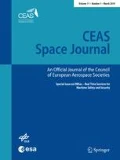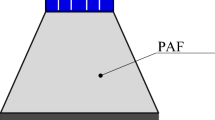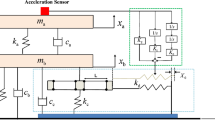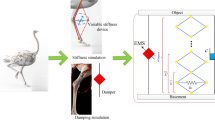Abstract
In this paper, a methodology to design a multi-frequency dynamic absorber for spacecrafts during the launch phase is presented. A dynamic absorber is a mechanical device which is able to reduce the magnitude of vibration imposed upon a primary structure. The modelling of dynamic coupling between the absorber and satellite is carried out via finite-element (FE) analysis of the coupled structure. The satellite response has been calculated to identify the contribution of the dynamic absorber and to quantify how such a device can improve the overall mechanical environment for the spacecraft during launch. Indeed, an analytical model is used to find relations and conditions to tune the multi-frequency absorber on satellite dynamics in order to improve the payload comfort within a specific frequency band. The feasibility and effectiveness of installing a dynamic absorber has been also illustrated by simulating the behaviour of the coupled absorber–satellite system via FE analysis for an actual case of a satellite vibration control. The results have confirmed the expectations of theoretical approach and modelling and have assessed the capability of the proposed design methodology.















Similar content being viewed by others
References
Ormondroyd, J., Den Hartog, J.P.: Theory of the dynamic vibration absorber. Trans. ASME. 9–22 (1928)
Den Hartog, J.P.: Mechanical Vibrations. McGraw Hill, New York (1956)
de Silva, C.W.: Vibration Damping, Control, and Design. CRC Press, Boca Raton (2007)
Asami, T., Nishihara, O., Baz, A.M.: Analytical solutions to H ∞ and H 2 optimization of dynamics vibration absorbers attached to damped linear systems. J. Vib. Acoust. 124, 284–296 (2002)
Jang, S.J., Choi, Y.J.: Geometrical design method of multi degree of freedom vibration absorber. J. Sound Vib. 303, 343–356 (2007)
Zuo, L., Nayfeh, S.A.: MiniMax optimization of multi-degree-of-freedom tuned-mass dampers. J. Sound Vib. 272, 893–908 (2004)
Ozer, M.B., Royston, T.J.: Extending Den Hartog’s vibration absorber techinique to multi-degree-of-freedom systems. J. Vib. Acoust. 127, 341–351 (2005)
Liu, L.K., Zheng, G.T.: Parameter analysis of PAF for whole-spacecraft vibration isolation. Aerosp. Sci. Technol. 11(6), 464–472 (2007)
Wilke, P.S., Johnson, C.D., Grosserode, P., Sciulli, D.: Whole-spacecraft vibration isolation for broadband attenuation. IEEE Aerosp. Conf. Proc. 4, 315–321 (2000)
Johnson, C.D., Wilke, P.S., Pendleton, S.C.: SoftRide vibration and shock isolation systems that protect spacecraft from launch dynamic environments. In: Proceedings of the 38th Aerospace Mechanisms Symposium, Langley Research Center, May 15–17, 2006
Johnson, C.D., Wilke, P.S.: The whole-spacecraft vibration isolation system-Its time has come. In: Johal, R.S., Wilke, P.S., Johnson, C.D.: Satellite Component Load Reduction using SoftRide. AIAA paper 99-4467. AIAA/6th Responsive Space Conference 2008
Evert, M.E., Janzen, P.C., Anderson, E.H.: Active Vibration Isolation System for Launch Load Alleviation. Smart Structures and Materials. Paper 5388-05 (2004)
Rittweger, A., Beig, H., Konstanzer, P., Dacal, R.B.: Feasibility demonstration of an active payload adapter for Ariane 5. In: European Conference on Spacecraft Structures, Materials and Mechanical Testing, pp. 1241–1251 (2005)
Chen, J., Fang, B., Yang, T., Huang, W.: Study of whole-spacecraft vibration isolators based on reliability method. Chin. J. Aeronaut. 22, 153 (2009)
Fei, H.Z., Zheng, G.T., Liu, Z.G.: An investigation into active vibration isolation based on predictive control. Part I: energy source control. J. Sound Vib. 296, 195–208 (2006)
Pierrick, J.: Isolation vibratoire par controle semi-actif d’amortisseurs magnéto-rhéologiques pour l’interface lanceur-charge utile. Thése de doctorat: Mécanique; CNAM, Paris (2006)
Géradin, M., Rixen, D.: Mechanical Vibrations. Wiley, New York (1997)
Calvi, A.: Uncertainty-based loads analysis for spacecraft: Finite element model validation and dynamic responses. Comput. Struct. 83(14), 1103–1112 (2005)
Pellissetti, M.F., Fransen, S.H.J.A., Pradlwarter, H.J., Calvi, A., Kreis, A., Schuller, G.I., Klein, M.: Stochastic launcher-satellite coupled dynamic analysis. J. Spacecr. Rockets 43(6), 1308–1318 (2006)
Fransen, S.: Methodologies for launcher-payload coupled dynamic analysis. European Space Agency (Special Publication), ESA SP 581, pp. 987–999 (2005)
Bernstein, D.: Matrix Mathematics. Princeton University Press, Princeton (2005)
Author information
Authors and Affiliations
Corresponding author
Rights and permissions
About this article
Cite this article
Mastroddi, F., Facchini, G. & Gaudenzi, P. Multi-frequency dynamic absorber for improved spacecraft comfort during the launch phase. CEAS Space J 3, 77–88 (2012). https://doi.org/10.1007/s12567-012-0026-1
Received:
Revised:
Accepted:
Published:
Issue Date:
DOI: https://doi.org/10.1007/s12567-012-0026-1




